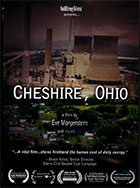
Cheshire, Ohio: An American Coal Story in 3 Acts 2017
Distributed by Bullfrog Films, PO Box 149, Oley, PA 19547; 800-543-FROG (3764)
Produced by Eve Morgenstern, Kim Connell
Directed by Eve Morgenstern
DVD, color and b&w, 75 min.
High School - General Adult
Environmentalism, Environmental Justice, Public Health, Activism, Ecology, Water Pollution, Air Pollution
Date Entered: 04/02/2018
Reviewed by Erin Rowley, University at Buffalo LibrariesCheshire, Ohio opens in 2013 on a small, nearly deserted town across the Ohio River from West Virginia. Looking back to 2002, the town had a population of over 200. Jumping back further in time, the film reminisces of a simpler time, when construction first began on a coal power plant in 1971, a plant named in honor of a decorated World War II officer, James M. Gavin.
The documentary delves into the effect the coal power plant, and the pollution it created, had on the residents of Cheshire, Ohio. Interviews were conducted with Cheshire residents in 2002 and 2013, including those who were employees at the Gavin Plant, as well as some who had moved to Cheshire as early as the 1930s.
The film provides an intimate history of the town, through individual stories as well as black and white 8mm film provided by Cheshire residents, but primarily focuses on two significant times in the town’s history: 2002 and 2013. When filmed in 2002, it followed shortly after American Electric Power (AEP), owner of the Gavin Plant, bought out the majority of town for 20 million dollars, paying the residents three times the assessed value of their homes. When filming resumed later in 2013, 77 AEP contractors and their families had recently filed a lawsuit against the billion dollar company for cancer and other diseases they allege were caused by working, unprotected, in the coal ash.
While the film does provide a brief history of the town and the power plant itself, it’s done so from the eyes of the residents and the law firms that had represented them. Significant points in history are mentioned, such as modifications to the plant in the mid-1990s due to Clean Air Act violations, but as the interviews are personal and anecdotal accounts, it’s unclear at times what is local lore and what is fact. The viewer is left without a perspective from AEP themselves, including what the true motivation for the town buyout was, even though avoiding lengthy and costly litigation is the reason most largely assumed. It is evident the documentary is intended to tell the story of the residents themselves, from a broader discussion, it could be viewed as one-sided.
In a time where climate change and human impact on the environment is a political issue, this film provides a deeply personal look at the impact of environmental damage on small town America. Overall the film is successful in adding to the already substantial discussion of pollution impacts, as well as the cost of our dependencies on carbon energy. The film will most certainly resonate with many viewers, especially those with closer or tangential ties to working class America.
As such, this documentary is highly recommended for audiences from high school to adult. The film could be helpful in an educational setting, to initiate classroom discussions on the ramifications of pollution. It would also be enjoyed by a general adult audience for those that are interested in documentaries in particular, or those that have an interest in the real world effects of pollution.
Awards:
- Special Juried Award, Frozen River Film Festival, 2018
- 1st Place Documentary Feature, Knoxville Film Festival, 2017
- Free Press Award, Columbus International Film & Video Festival, 2017
- Sir Edmund Hillary Award, Mountain Film Festival, 2017